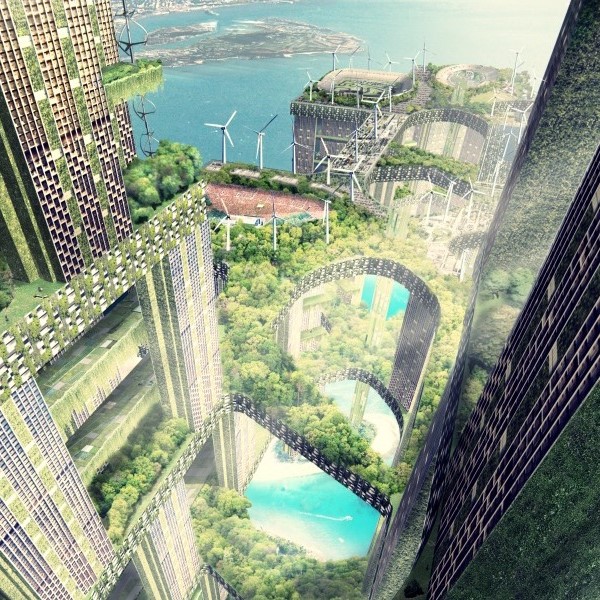WOHA is interested in creative solutions to the big issues that face all of us – how to build sustainably; how to create diverse and delightful environments; how the built environment can create and enhance a sense of community; how we can achieve density yet improve amenity; how do we make buildings meaningful and loved; what do we mean by a good building? WOHA continues research into these broad issues, while delivering specific crafted projects that incorporate the results of this speculative process into their fabric. WOHA’s projects aim to be generous, benefitting the owner, the end user, the precinct, the city at large as well as the broader environment.
WOHA’s architecture is not based on any house style or set of solutions, but allows the architectural expression to emerge from the answers to these big questions. WOHA’s architecture emerges from a profound awareness of local context and tradition, as well as an ongoing exploration of contemporary architectural forms and ideas, a unique fusion of deep connection and playful invention. Environmental principles have always been fundamental to WOHA’s designs, and are deeply embedded in the concept rather than a technological overlay.
WOHA believes good design must arise from this thoughtful process of study and research, which is combined with technical knowledge, social and political understanding, then synthesised through creative skill and artistic judgement. The unavoidable random and unforeseen events that occur in every project do not derail the process, rather they allow the possibility of adding richness and surprising solutions to the design. Robustness, attention to detail, proportions, and scale, together with common sense, stoicism, and a sense of humour ensure a completed project that is a step towards a better world.
WOHA Rating System
WOHA has developed its own rating system to try to measure the things it values as opposed to the indices that are commonly used by developers to measure how well a building performs. The ratings are laid out in more detail in the book “Garden City, Mega City“. For instance, a high surface area to volume ratio essentially translates into how the fewest number of windows can be shared by the highest number of people. WOHA’s system counterbalances these “unpleasantness-indices” by measuring five key ratios: Green Plot Ratio, Community Plot Ratio, Civic Generosity Index, Ecosystem Contribution Index and the Self-Sufficiency Index.
The Green Plot Ratio measures the amount of landscaped surfaces compared to a development’s site area. The measurement includes all new and preserved vegetation, vertical and horizontal landscaping, water features, lawns and trees, raised planters, and urban farms. All buildings need to encourage biodiversity, reduce the urban heat island effect, provide shade and cooling, improve air quality, soften the harshness of the cityscape, restore wildlife habitats, and re-connect people with nature.
The Community Plot Ratio measures the amount of community space allocated within a development’s site area. The measurement includes fully public areas, semi-private communal spaces, care centres, libraries, restaurants, cafés, and community centres. The amenity of an urban precinct is largely determined by the quantity and quality of its community spaces. The buildings should encourage human interaction and facilitate social gatherings. Human scale, accessibility, and inclusivity are crucial to the success of community integration.
The Civic Generosity Index measures the extent to which a development encourages and facilitates the public life of a city. It rates the value of a development’s public attributes, such as urban connections, shared relaxation areas, sheltered walkways, gardens, and artworks. In a sociable city, buildings should be judged by their ‘human’ characteristic: are they friendly, generous, and accommodating?
The Ecosystem Contribution Index measures the degree to which a development supplements a city’s ecosystem. It rates a development’s capacity to maintain connections between natural habitats; its intention to provide food, water and shelter for local wildlife, and settings for native plants; and its implementation of an environmentally sensitive method for water management. As land in cities can be more successfully adapted for wildlife preservation than that of agricultural zones, building developments now play a key role in regenerating a city’s (and a region’s) ecological processes. In order to reverse the unprecedented environmental degradation caused by rapid urbanisation, a city’s architects, planners, and developers must view buildings as homes for flora and fauna, as well as people.
The Self-Sufficiency Index measures a development’s capacity to provide its own energy, food and water. It rates the success of a development’s energy, food and water production; the amount of its surfaces allocated to solar collection and urban farming; and the extent of its systems for recycling and harvesting natural resources. In a sustainable city, buildings must aim to be completely self-sufficient: they must produce as much energy as they consume, and preferably more, in order to compensate for existing high-maintenance buildings.

